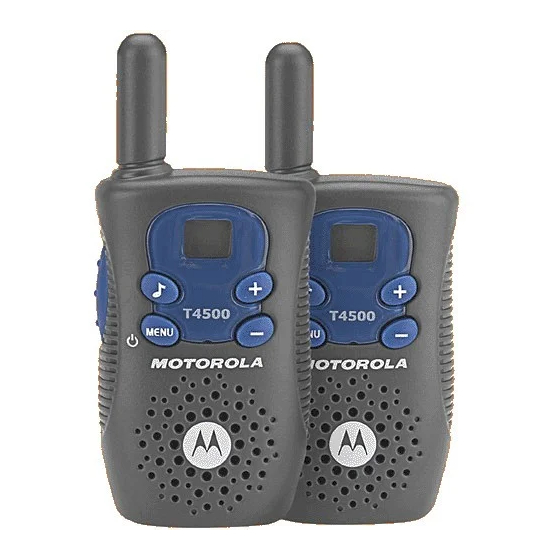
Table of Contents
Advertisement
Advertisement
Table of Contents

Summary of Contents for Motorola T4500
- Page 1 Two-Way Radio User's Guide @6881043B35@ Model T4500 6881043B35-A...
- Page 2 Please retain your original dated sales receipt for your records. For warranty service of your Motorola product, you will need to provide a copy of your dated sales receipt to confirm warranty status. Registration is not required for warranty coverage.
-
Page 3: Finding Controls
Finding the Controls... - Page 4 # - Short press sends call tone. Push to Talk (PTT) • Push to transmit, release to listen. • In menu mode, push to confirm selection. • Long press turns radio on or off. • Short press enters menu mode, where: first press changes channel, second press turns scan on or off, third press monitors...
-
Page 5: Installing Batteries
Installing the Batteries Your radio uses 3 AAA Alkaline batteries, and beeps when the batteries are low. 1. Turn the radio off. 2. Use a coin to wedge the battery cover open. 3. Insert batteries as shown on inside of battery compartment. -
Page 6: Frequencies
Channel 462.5625 MHz 462.5875 MHz 462.6125 MHz 462.6375 MHz 462.6625 MHz 462.6875 MHz 462.7125 MHz 467.5625 MHz 467.5875 MHz 467.6125 MHz 467.6375 MHz 467.6625 MHz 467.6875 MHz 467.7125 MHz 462.5500 MHz 462.5750 MHz 462.6000 MHz Frequency Description GMRS/FRS GMRS/FRS GMRS/FRS GMRS/FRS GMRS/FRS GMRS/FRS... - Page 7 Channel 462.6250 MHz 462.6500 MHz 462.6750 MHz 462.7000 MHz 462.7250 MHz Talking and Listening To talk, press and hold the PTT button. When you are finished talking, release PTT. For maximum clarity, hold the radio 2 to 3 inches away from your mouth and speak directly into the microphone.
- Page 8 Scanning Channels Use scanning to monitor channels and codes for transmissions, or to find someone in your group who has accidentally changed channels. 1. Press or – display. 2. Press either: % until Y displays to turn scanning on. & until – displays to turn scanning off.
-
Page 9: Attaching Belt Clip
Attaching the Belt Clip (Included) Hook the belt clip into the notch at the top of the radio and slide down until it clicks into place. To remove, squeeze the release latch together and slide the clip up and away from the radio. -
Page 10: Fcc Licensing Information
Regarding FCC license Changes or modifications not expressly approved by Motorola may void the user’s authority granted by the FCC to operate this radio and should not be made. To comply with FCC requirements, transmitter adjustments should be made only by... -
Page 11: Safety And General Information
July 2000. Transmit and Receive Procedure Your two-way radio contains a transmitter and a receiver. To control your exposure and ensure compliance with the general population/ uncontrolled environment exposure limits, always adhere to the following procedure: •... - Page 12 (in terms of measuring standards compliance). Exposure to Radio Frequency Energy Your Motorola radio is designed to comply with the following national and international standards and guidelines regarding exposure of human beings to radio frequency electromagnetic energy: •...
- Page 13 To maintain compliance with FCC/Health Canada RF exposure guidelines, if you wear a radio on your body when transmitting, always place the radio in a Motorola-supplied or approved clip, Two-Way Radio Operation When using your radio as a traditional two-way radio, hold the...
-
Page 14: Approved Accessories
(2.5 cm) from the body. Approved Accessories For a list of approved Motorola accessories visit our website at www.mot.com. Electromagnetic Interference/Compatibility Note: Nearly every electronic device is... - Page 15 Aircraft When instructed to do so, turn off your radio when on board an aircraft. Any use of a radio must be in accordance with applicable regulations per airline crew instructions. Medical Devices - Pacemakers The Advanced Medical Technology Association recommends that a minimum separation of six inches (15 cm) be maintained between a handheld wireless radio and a pacemaker.
-
Page 16: Operational Warnings
Other Medical Devices If you use any other personal medical device, consult the manufacturer of your device to determine if it is adequately shielded from RF energy. Your physician may be able to assist you in obtaining this information. Safety and General Use While Driving Check the laws and regulations on the use of radios in the area where you drive. -
Page 17: Operational Cautions
Blasting Caps and Areas To avoid possible interference with blasting operations, turn off your radio when you are near electrical blasting caps, in a blasting area, or in areas posted: “Turn off two-way radio.” Obey all signs and instructions. Operational Cautions Antennas Do not use any portable radio that has a damaged antenna. - Page 18 Batteries All batteries can cause property damage and/or bodily injury such as burns if a conductive material such as jewelry, keys, or beaded chains touch exposed terminals. The conductive material may complete an electrical circuit (short circuit) and become quite hot. Exercise care in handling any charged battery, particularly when placing it inside a pocket, purse, or other container with metal objects.
- Page 19 6. Use of an attachment not recommended or sold by Motorola may result in a risk of fire, electric shock, or personal injury. 7. Make sure the cord is located so it will not be stepped on, tripped over, or subjected to dam- age or stress.
-
Page 20: Talk Confirmation Tone
Not for children under 3 years. This product is not intended to be used MOTOROLA and the Stylized M Logo are registered in the US Patent & Trademark Office. All other product or service names are the property of their respective owners.











